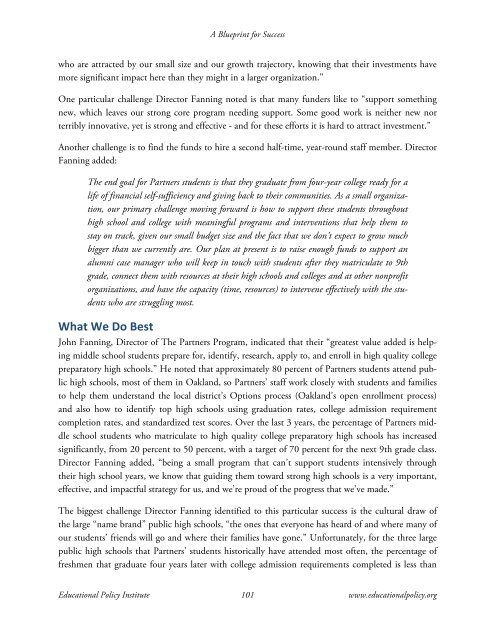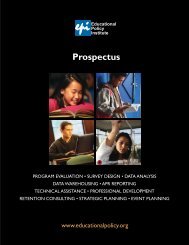A BluePrint for Success: Case Studies of Successful - Educational ...
A BluePrint for Success: Case Studies of Successful - Educational ...
A BluePrint for Success: Case Studies of Successful - Educational ...
You also want an ePaper? Increase the reach of your titles
YUMPU automatically turns print PDFs into web optimized ePapers that Google loves.
A Blueprint <strong>for</strong> <strong>Success</strong><br />
who are attracted by our small size and our growth trajectory, knowing that their investments have<br />
more significant impact here than they might in a larger organization.”<br />
One particular challenge Director Fanning noted is that many funders like to “support something<br />
new, which leaves our strong core program needing support. Some good work is neither new nor<br />
terribly innovative, yet is strong and effective - and <strong>for</strong> these ef<strong>for</strong>ts it is hard to attract investment.”<br />
Another challenge is to find the funds to hire a second half-time, year-round staff member. Director<br />
Fanning added:<br />
The end goal <strong>for</strong> Partners students is that they graduate from four-year college ready <strong>for</strong> a<br />
life <strong>of</strong> financial self-sufficiency and giving back to their communities. As a small organization,<br />
our primary challenge moving <strong>for</strong>ward is how to support these students throughout<br />
high school and college with meaningful programs and interventions that help them to<br />
stay on track, given our small budget size and the fact that we don’t expect to grow much<br />
bigger than we currently are. Our plan at present is to raise enough funds to support an<br />
alumni case manager who will keep in touch with students after they matriculate to 9th<br />
grade, connect them with resources at their high schools and colleges and at other nonpr<strong>of</strong>it<br />
organizations, and have the capacity (time, resources) to intervene effectively with the students<br />
who are struggling most.<br />
What We Do Best<br />
John Fanning, Director <strong>of</strong> The Partners Program, indicated that their “greatest value added is helping<br />
middle school students prepare <strong>for</strong>, identify, research, apply to, and enroll in high quality college<br />
preparatory high schools.” He noted that approximately 80 percent <strong>of</strong> Partners students attend public<br />
high schools, most <strong>of</strong> them in Oakland, so Partners’ staff work closely with students and families<br />
to help them understand the local district’s Options process (Oakland’s open enrollment process)<br />
and also how to identify top high schools using graduation rates, college admission requirement<br />
completion rates, and standardized test scores. Over the last 3 years, the percentage <strong>of</strong> Partners middle<br />
school students who matriculate to high quality college preparatory high schools has increased<br />
significantly, from 20 percent to 50 percent, with a target <strong>of</strong> 70 percent <strong>for</strong> the next 9th grade class.<br />
Director Fanning added, “being a small program that can’t support students intensively through<br />
their high school years, we know that guiding them toward strong high schools is a very important,<br />
effective, and impactful strategy <strong>for</strong> us, and we’re proud <strong>of</strong> the progress that we’ve made.”<br />
The biggest challenge Director Fanning identified to this particular success is the cultural draw <strong>of</strong><br />
the large “name brand” public high schools, “the ones that everyone has heard <strong>of</strong> and where many <strong>of</strong><br />
our students’ friends will go and where their families have gone.” Un<strong>for</strong>tunately, <strong>for</strong> the three large<br />
public high schools that Partners’ students historically have attended most <strong>of</strong>ten, the percentage <strong>of</strong><br />
freshmen that graduate four years later with college admission requirements completed is less than<br />
<strong>Educational</strong> Policy Institute 101 www.educationalpolicy.org




